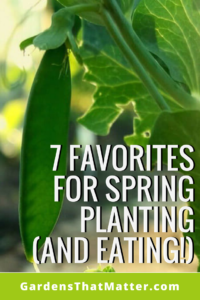7 Favorites for Spring Planting (and Eating!)
“Plant as soon as the soil can be worked.” Reading instructions on a seed packet, these words make me smile in late winter and early spring. When we get sunny weekends, I can hardly wait to get out into the garden. If you’ve still got frosts ahead, but you have the same itch to plant something NOW, here are seven of my favorite things to plant (and eat) in spring time.
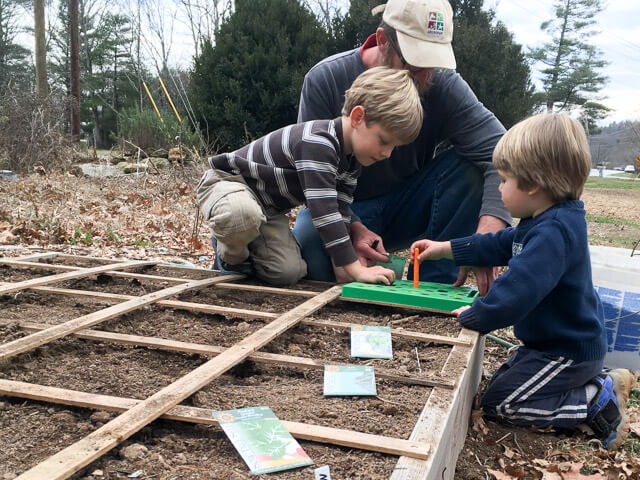
Colby and the boys use a spacing square in the raised bed. Maybe we won’t over seed this year after all!
If your soil is wet, wait a bit longer to start working in your garden. Digging, tilling, or even just walking across wet soil will compact it…and compacted soil is bad news for plant roots and soil life. Not sure? Take a handful and squeeze it. If you muddy water drips out, your soil is too wet. If you only get a drop or two, you’ll probably be okay to start working, but limit soil disturbance as much as you can.
I’ll include links to sources of open-pollinated seeds for each item, but you may want to see if you have a local seed company who offers something similar.
1. Peas
The boys and I love hunting for pea pods in the garden and eating them right off the vines. I’d like to grow some flat snow peas, Mammoth Melting Sugar, on a trellis this year and freeze them for winter stir fries (if enough extras make it back to the house!). I’d also like to try growing shorter Sugar Ann snap peas without a trellis. As much as I love those curly tendrils, it’s easier to plant something in the same area later in the season, if I don’t have to untangle trellis string and poles!
2. Spinach
I tend to stick with the classic Bloomsdale variety with its savoyed (crinkled!) leaves and deep green color. Spinach is hands-down our family’s favorite green to eat, so this year, I’m going to add some Giant Noble Spinach for the big leaves. Later, I’ll also plant the not-actually-spinach Malabar spinach, a beautiful vine with spinach-like leaves that grow all summer long.
Spinach seeds can be planted all winter long (in most regions), and they’ll emerge up when the temperatures and day lengths are right. If you’re planting later in spring, soak the seeds overnight for better germination rates.
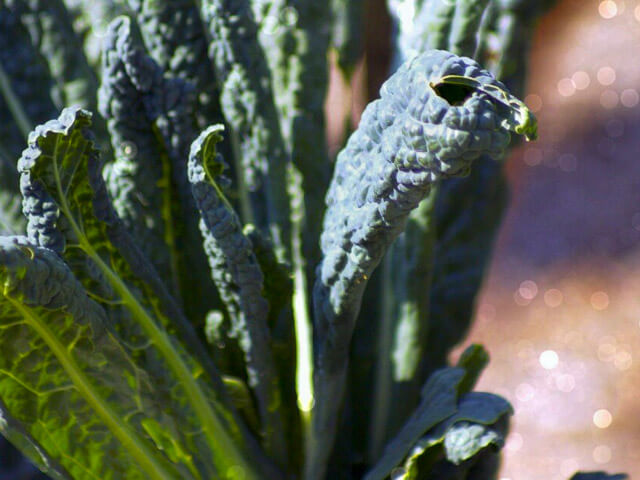
3. Kale
The boys aren’t kale converts yet, but I’m hoping to sell them on Dino Kale (a.k.a. Lacinato or black kale) in the form of kale chips. I like to plant kale (and all greens) without worrying much about seed spacing, partly because my kids do not get the concept at all. 🙂 The other reason is that I’ll come back to thin the overplanted baby kale with scissors and use the tiny leaves in smoothies and cooking. The rest of the plants will have room to grow.
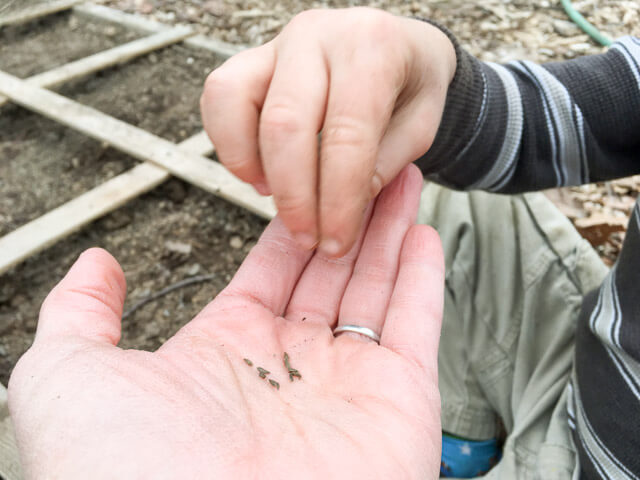
Planting lettuce seeds a few at a time!
4. Lettuce
We don’t eat salads every night for dinner, but as you might guess, I have aspirations. Lettuce gets a place in our spring planting plans because the season is perfect for them. Some varieties won’t come up until temperatures get a bit warmer, but if I plant early, summer doesn’t sneak up on me. Most lettuces “bolt” in hot weather. The heat and long days of summer signal that its time for them to shoot up those flower stalks and make seeds. Unfortunately, that means bitter leaves for the lettuce eaters. We’re planting Buttercrunch this year, a variety that is slow to bolt if we do want to try a late planting.
The next three plants are long-term perennials that shine in spring.
5. Arugula
Also known as rocket, arugula is my favorite intentional “weed” and I always let a few plants go to seed each year. Depending on where you live, you can let annual arugula self-seed and volunteer, or you can choose Sylvetta perennial arugula. If you harvest the outer leaves, the lobed leaves will keep growing from the plant’s center, and you can enjoy their peppery kick for months.
Our fall-planted arugula has been chillin’ under mulch the last couple months. It should really take off in the next couple weeks!
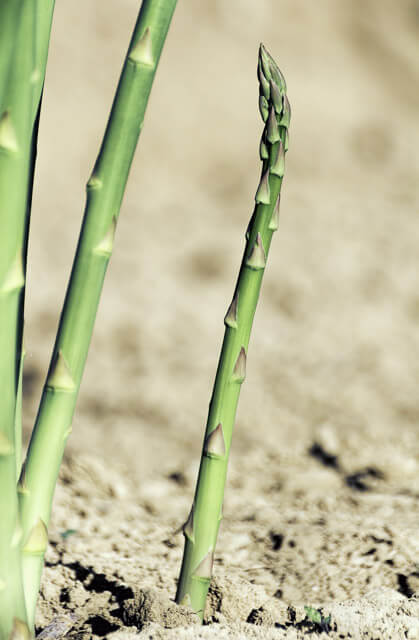
6. Asparagus
Walking across the yard to get a tool for Colby, I never made it back to his shop. “OH! Asparagus!” he heard me exclaim. A few minutes later, he came to get the screwdriver himself, because really, who can run errands when the asparagus is up?! 🙂
If you’ve got the patience, you can go the thrifty route and plant asparagus as seeds. Start them in a protected area (where you can keep an eye on the little wispy youngsters). The next year, you can transplant the crowns into a permanent growing area. You’ll need to wait until their fourth year to start harvesting those lovely spears. (This gives the plants time to get well-established. It’s hard to wait, but it’s worth it for a planting that will produce for 20 years or more!)
Or buy asparagus crowns for a faster payoff. You can usually start harvesting a few spears during the second season when you plant crowns. Depending on your location, growers will ship asparagus crowns in February and March. Plant them in a fertile, well-drained area that you’ve prepared ahead of time. This is a situation where you really want to get in and remove the weeds and grass growing in the area. Asparagus doesn’t like to compete! Once your asparagus is up, you can use thick mulch to keep those competitors at bay.

7. Strawberries
While we won’t get to eat strawberries until closer to summer, spring is the ideal time to plant bare-root strawberries. I’m in love with Seascape and the big berries they produce all summer long. We ordered ours from the local 4-H, and we’ll order more this year to expand our strawberry patch. I don’t think one strawberry made it inside last year!
Although mail-order companies will ship bare-root plants this time of year, I recommend you find a local source if possible. In that source, you’ll likely also find a local expert who can help you choose from varieties that are well-adapted to your region and its disease pressures.
There’s a Goldilocks aspect to planting strawberries…not too deep and not too shallow. You want to get the soil level juuuuust right! (Here’s a page all about strawberries with an illustration of the proper depth halfway down.)
We prepare a planting area by adding a layer of compost and loosening the soil with a digging fork. Then, I dig a small hole, leaving a small mound of soil in the middle. I spread the roots of the strawberry over the mound, putting the crown right at soil level, and then fill in over the roots. Mulch and done. (Mulch can encourage slugs and snails, which love perfectly ripe strawberries. If you have lots of these mollusks, you may want to keep mulch pulled back from the base of the plants.)
If you want even more ideas for spring, here’s an article from Growing for Market and Johnny’s Seeds. While it’s written for market gardeners, they include some useful suggestions eighteen different options and even suggest some early varieties.
I’ll be outside this weekend planting. 🙂
What about you?
Leave a comment and let us know about your spring favorites!

